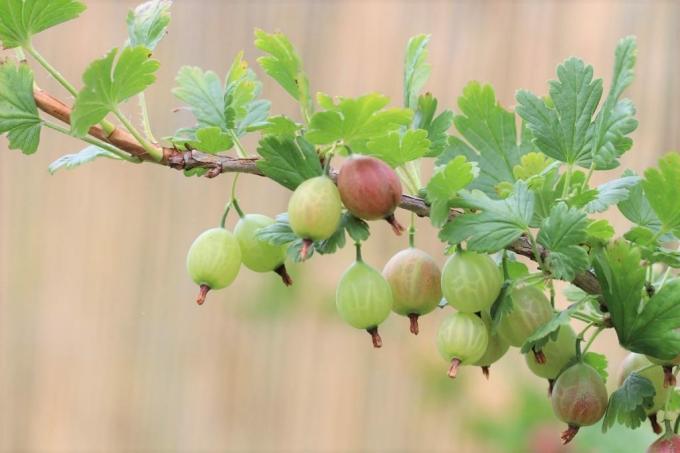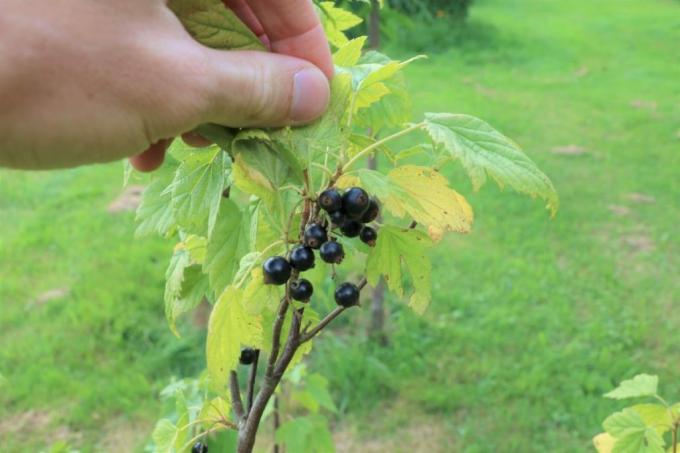
table of contents
- Leaf fall disease explained
- Symptoms
- Recognize other diseases
- Fight in time
- Prevent early
- frequently asked Questions
How do I recognize leaf fall disease and how is it combated? Is it dangerous? This article will tell you what to do when currant leaves are curling.
In a nutshell
- The disease occurs particularly in wet periods, but not life-threatening, but combating is recommended
- first characteristics: spots / dots on the upper side of the leaves, initially yellow, later brown-black, increasingly larger
- later leaves curl, edges dry up and, finally, leaves fall prematurely
- Control: pruning measures, strengthening with plant manure, renouncing artificial fertilizers and disposing of the diseased leaves
- Preventive measures: sunny and airy location, light cut, plant strengthening and use of resistant varieties
Leaf fall disease explained
It is a fungal disease caused by the Drepanopeziza fungus. It only attacks the gooseberry family, more precisely their only genus currants, botanically Ribes. This in turn consists of various types of currants and gooseberries. The mushroom does not spare any Ribes species. In a home garden the following are the main ones
Currant species cultivated:- Red currants (Ribes rubrum)
- Black currants (Ribes nigrum)
- Gold currants (Ribes aureum)
- Alpine currants (Ribes alpinum)
- Blood currants (Ribes sanguineum)

Note: Even the cultivated ones Gooseberries (Ribes uva-crispa) and the josta berries (Ribes x nidigrolaria) can suffer from this disease.
Time window of illness
Currants are attacked between May and July. The harvest time also falls in this time window, which, depending on the variety and the current weather, runs from mid-June to around the beginning of August. But it is by no means said that this disease has to occur frequently or even every year. Many currants in the home garden will even be spared their lives.
Conducive conditions
This fungus needs moisture to spread. Damp, rainy spring days pose the greatest risk of infection. It is also beneficial if the temperature is around 12 ° C at the same time. The fungus lurks in the ground, where it usually got through the fallen leaves of the previous year, survived the winter there unscathed and formed new spores in the spring. It first reaches the nearby lower leaf specimens and is then carried higher and higher by the wind, up to the tips.
Symptoms
If this disease is completely ignored, it will ultimately lead to leaf fall. But long before that, she showed other symptoms. In the first place, there is no curling of the leaves, but mainly spots form on them. But first of all, reassurance: as terrifying as this disease may seem, it is not life-threatening for Ribes.

Source: Jerzy Opioła, Drepanopeziza ribis a2 (1), Edited by Plantopedia, CC BY-SA 4.0
These are the visible signs by which you can recognize leaf fall disease:
- small, round spots (dots) on the upper side of the sheet
- initially yellow, later brown-black in color
- speckled leaves
- Spots grow larger, flow together
- until they cover almost the entire sheet
- Leaves curl or curl upwards
- sometimes this is referred to as leaf curling
- Leaf margins yellow and dry up increasingly
- Result: premature leaf fall
If, for whatever reason, the owner fails to fight the disease, the affected currant will be left with bare branches shortly after the harvest time. But it will drive out again in due course.
Recognize other diseases
Leaf spots are one of the common symptoms of plant diseases. But if you take a closer look, you will quickly see the tell-tale traits. The time of the illness is also decisive:
- Nettle leaves: leaves slowly turn brown to black
- is accompanied by weak shoots and weak flower formation
- only affects black currants
- Column rust occurs only in autumn
- shows up with red pustules on the leaves
- Red pustular disease occurs in midsummer
- it also shows up with red pustules

Tip: In the case of currants, it should also be checked whether leaf changes were caused by drought. In doing so, however, the entire leaf usually turns yellow without really looking blotchy.
Fight in time
Even if this fungal disease leaves the bushes alive, you should still fight it as soon as it is discovered. There is no need for the vitality of the plant to suffer and the yield to decline. The stained leaves are also not a sight that a hardworking gardener would want to put up with. By combating it, you also reduce the risk of a renewed infection in the following year or spreading to still healthy bushes.
Use scissors in the early stages
If the fungus is still in the early stages of its conquest, the easiest way to contain it is with the scissors. Cut Completely remove severely affected branches. Take a close look at all the leaves on the remaining branches and remove any stained specimens. If a currant is still young and has only a few shoots, do not cut it off. Instead, remove each infected leaf by hand.
Tip: Disinfect the cutting tool before and after use to avoid spreading fungal pathogens. Experts argue about whether plant material infected with this pathogen can be composted. You play it safe when you dispose of it as residual waste.
Strengthen the plant

With plant broths you can specifically strengthen the resistance of currants so that they can better defend themselves against the fungus. Depending on which broth is easiest for you to make, you can Nettle manure, Horsetail broths, Garlic broth or onion peel broth.
- spray on warm, sunny days
- but not in the blazing midday sun
- The process can be repeated several times a week
Avoid artificial fertilizers
Immediately after discovering the disease, stop using nitrogen-laden artificial fertilizers if you are not already doing so. This is how you lower the infestation pressure.
Collect leaves in case of severe infestation
If the symptoms of the disease appear late and only moderately, the leaves are allowed to rot on the spot. If the disease progresses seriously, you should collect and dispose of the fallen leaves as soon as possible.
Prevent early
The occurrence or You can prevent the widespread spread of this disease in advance if you take the currant to one Plant a suitable location, maintain it properly and, if possible, take appropriate measures to maintain its vitality strengthen.

In summary, you should implement the following points:
- choose a sunny, airy location
- Do not plant the bed too closely, make sure there is enough planting distance
- possibly. remove or remove a few bushes afterwards. transplant
- if necessary, thin out vigorously when cutting
- Thinning out shading trees as well
Tip: By not using nitrogen-laden artificial fertilizers, you should not only rule in the event of illness, but also generally prevent an infestation. Organic fertilizers and the aforementioned liquid manure are ideal as fertilizers for ribes.
Rely on resistant varieties
If you want to bring a few new currant bushes into the garden, ask specialist shops for advice on resistant varieties. Although these varieties are not completely resistant, they are less likely to get sick or survive the disease better.
Tip: The black currant suffers from this disease less often than the red currant or the white currant. It is the better choice, especially in rainy regions of the country.
A few words about fungicides
No fungicides against this fungal pathogen are currently approved for the home garden. Given that it is not dangerous, there is also no need to resort to toxic and environmentally harmful agents. It is better to encounter the curling leaves in the ways described above.
frequently asked Questions
The gooseberries get sick later in the year. The visible symptoms usually show up after the harvest.
Even if you fail to recognize and / or not combat the disease, the fruits remain untouched. They can be eaten without restrictions, and their taste does not suffer either. However, it is possible that the harvest volume will be somewhat reduced.
There are a few varieties, for example 'Rondom', 'Stanza', 'Tatran' or 'Rote Vierländer'.
There is a fungal disease called curl disease. But that means another disease that affects almond, peach and nectarine trees.
